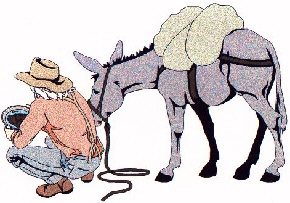 |
| Vol. 7, No. 3 | March 2002 | |
|
Lloyd G. Clements Community Center
7:00 PM (Board Meeting at 6:00 PM)
|
by Gary Hawley
Greetings to all "Gold Prospectors of the Rockies" members.
Our club meetings continue to grow and new friendships are formed every time. If you are missing the meetings, you are passing up a chance to gain another mining partner, find new places to go prospecting, or just have a good time. (The food is darned good, too!)
Check elsewhere in this newsletter for my VP's Q&A. This one might be easy, unless it's a trick question.
On the serious side, Jefferson County Open Space has acquired 3,265 acres in Clear Creek Canyon. This encompasses both sides of the creek from Tunnel #1, just west of Golden, to the area where highway 119 branches off U.S. 6 and heads to Black Hawk. This area has already been given the name of Clear Creek Canyon Park.
On February 28, approximately 12 other club members and myself attended a "Public Input" meeting presented by Jefferson County Open Space. All attending members handled themselves in a very professional manner. Questions were asked and answered. Open Space personnel were polite and we were warmly welcomed.
How does this affect our prospecting in the canyon? The basic rule is one cannot remove any natural resource from open space land (except fish). However, they understand the historic value of the canyon and the part that gold played in transforming this area into what it is today. At this point, they are interested in our hobby and are trying to figure out how to accommodate our interest in the canyon.
Quoting their handout of Feb. 28 - "Generate Draft Alternatives - A Review of data from the open house will be assessed by the Clear Creek Advisory Committee (CCAC) April - May."
I have offered to have our members demonstrate recreational gold prospecting to the Advisory Committee so they can see that we are responsible people who are willing to work with the Committee. This offer was welcomed and we will be presenting this demonstration as soon as the weather allows.
It is my belief that we have a chance to keep at least a portion of the canyon available to prospecting. We need to keep our heads and maintain a professional attitude. Arguments and threats will not help.
I will have more information at the club meeting and will keep you informed through the newsletter. Until next time, may the nuggets you find be worth the effort you put into finding them.
by Gary Hawley
Another six members correctly answered the February V. P.'s Q&A question and five names were drawn to receive a free ticket for the prize drawing. The question for February was: What was the original name of the Argo Tunnel in Idaho Springs? The answer is the Newhouse Tunnel. OK, here is an easy one for the March question: Miners of old drilled blast holes in a mine's face with hammers and drill steel. What was the name of the method used when one man held the steel and another swung an eight-pound hammer?
by Doug Taylor
The Clark, Gruber, & Company banking firm was established in Leavenworth in 1857 by Milton E. and Austin M. Clark (brothers), and E.H Gruber. They opened a new branch house in Denver in 1859. Denver was in dire need of coinage. Most of the business transactions were conducted with gold dust and the purity of the gold was always an issue--was it 16 caret or 20 caret? The shopkeepers usually came out ahead in transactions with the miners. If the miner sent his gold back east for exchange he had to pay for shipping
and by the time he got it back his cost had brought the price lower then what the local shopkeepers would give him.
The privately operated mint was just what the miners and Denver needed. The building was located at 16th and Market Streets and started to produce coinage on July 20, 1860. They issued coins with their own stamp upon it, in denominations of $20, $10, $5, and $2.50. They had the best of facilities for assaying and designed to have their coins so pure that it would be worth par at the U.S. mint.
The $10 gold piece displayed on one side the American eagle, and the words "Clark, Gruber & Co" near the edge of the coin, with the date 1860 in the usual place. On the reverse side is a picture of the "Peak" with the words "Pikes Peak Gold" above and Denver beneath it. 'Ten-D" (ten dollars) appears in its appropriate position.
The first year of coins came from unalloyed native gold. It was soon discovered that they abraded too easily and for the second year's production in 1861, an alloy was added to harden the coins for circulation.
On April 21, 1862, the Government acquired the Clark, Gruber & Company for $25,000. Unlike Clark, Gruber & Company, the Denver plant performed no coinage of gold as first intended. One reason given by the Director of the Mint for lack of coinage was, " the hostility of the Indian tribes along the routes, doubtless instigated by rebel emissaries (there being a Civil War) and bad white men."
John J. Conway & Company started another Territorial mint. Very little is known regarding the mint except that it operated in Parkville, Summit County in the summer of 1861. Conway & Company, jewelers, and bankers advertised to receive gold dust and coin it into $2-1/2, $5 and & $10 gold pieces. An unknown quantity of such coins was
produced at its mint.
Another short-lived entrant in the game of coining Colorado gold was Dr. John D. Parsons who in partnership with Mr. Black formed Parsons & Company. Setting up his assaying and minting equipment near Terryall in the South Park of Colorado. The coins are undated but the Weekly News of Denver and the Miner's Record issued at Tarryall carried news items in 1861 concerning the J. Parsons and Co. gold coinage.
The final curtain came down on private coinage with Congress' passage of the Act of June 8, 1864. This act intended to stop the minting of Civil War tokens. This legislation prohibited the private manufacture of any coins designed to pass as money.
by Doug Taylor
We had a good turn out for the February Find of the Month/ Year program. David Blackard brought in an old miner's pick he found near Frisco. Larry Weilnau had some Topaz and Quartz to display that he found in his gold pan while in Terryall. Gale Herbertson had a pile of coins on the table that he found while vacationing in Florida; Gale used a metal locator to recover his finds. Randy Solomon had a gold specimen from the Cargo Mucho Mountains of California and a penny weight nugget from La Cienega Sonora Mexico that he found using a metal detector while on vacation. After the votes were cast, the members decided that Randy's gold was the Find of the Month! Nice find Randy. Thanks to all who participated in the program and remember to keep your head down and eyes open!
|
|
|
| 0.7 gram nugget - | Corky Frandsen |
| 0.6 gram nugget - | Corky Frandsen |
| 0.6 gram nugget - | Elizabeth Schlomer |
| 0.8 gram nugget - | Jim Davis |
| 0.6 gram nugget - | Ed Finney |
| 0.6 gram nugget - | Jerry Jones |
| 0.8 gram nugget - | Kindra Solomon |
| 0.9 gram nugget - | Donovan Greene |
| 0.9 gram nugget - | James Elkin |
| 0.9 gram nugget - | Mitchel McConnell |
| 1.0 gram nugget - | Mike Boyhwell |
| 1.3 gram nugget - | Mitchel McConnell |
|
|
|
| 0.5 gram nugget - | David Blackard donated by Randy Solomon |
| Raw Emerald - | Gary Hawley donated by Jim Davis |
| Raw Emerald - | Kindra Solomon donated by Jim Davis |
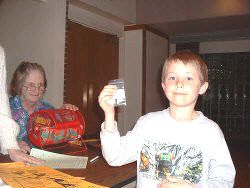
Mitchell McConnell was very
excited about winning two times!
by Rick Miska
The following is part of a four part letter that we received from the United States Department of the Interior. It is a list of stipulations and conditions for recreational prospecting on public lands along the Arkansas River. This applies to work conducted on public lands along the Arkansas River in the Royal Gorge Field Office and not for any USFS lands in the region. I will cover this in our next meeting, but wanted to get the main part of the information out to you ASAP.
Stipulations
- Water based operations are prohibited in waterways between October 1 and March 31 to protect brown trout during the fish spawning period.
- Stream side (riparian) vegetation and shoreline banks shall not be damaged, undercut, or otherwise impacted by operations.
- All materials too large in size to be moved by hand or hand held implements shall remain undisturbed.
- Refueling of motorized equipment shall take place at least 20 feet from the waterway or adjacent wetlands.
- Motorized vehicles are restricted to designated roads and parking areas and shall be kept a minimum distance of 20 feet from all waterways, developed recreation sites, stream side vegetations areas, or wetland sites. If any road construction or earth moving is planned, utilize the supplemental sheet. (I will bring these to the meeting).
- Operations shall not take place within 200 feet of a pulic water supply intake, fish hatchery intake, irrigation diversion structure, bridge support, or boat ramp.
- Anchorage systems for suction dredging operations shall not span the stream or interfere with the passage of water craft.
- Camping is limited to 14 days at any one site with a requirement to move at least 5 miles at the end of the 14 days.
- On shore activities (highbanking) are not authorized on steep slopes or in areas that would result in safety hazards or undercutting of vegetation.
- On shore excavation locations shall be refilled prior to completion of work.
- Collection or disturbance of historic or archaeological resources or sites is not authorized.
- All operations are required to comply with applicable state or federal regulations pertaining to endangered species.
Conditions
- Over the counter approval can be obtained for only those operations that are proposed within the Point Bar Area, Woody's Claim, or the GPAA area north of Buena Vista and are within the limits listed below. All other proposals will require a minimum 15-day review period.
- Suction dredging equipment is limited to 4 inch nozzles and 8hp motors for water based operations.
- On shore equipment is limited to 2 inch diameter nozzle/hose for the purposes of pumping water with a 8hp limit in total motor size.
- Dry washers are limited to 8hp motors.
- Non motorized operations (no pumps or motors) do not require any permit, but stipulations still apply.
- Within the Point Bar and Woody's Clain area only: on shore sluice box equipment is authorized during the time period of October to April 1. Equipment size is limited to 1hp motors with a 1inch nozzle. No pumping of water from the river is authorized during this time period.
- In order to utilize the GPAA site and Woody's Claim, you will need permission from the claim owners in addition to this authorization. Mining claimants can further restrict these conditions and stipulations.
- Additional day use and camping fees may be required at developed sites.
- Bonding funds will be placed into a bond pool and will be applied towards reclaimation, cleanup, and maintenance of access within the work areas for which the bond was collected.
- A copy of the application and stipulations shall be in your possession when working at approved locations.
The authority for this application, conditions, and stipulations is derived from the 43 cfr 3809 regulations.
June 24, 1870, was a significant moment in Denver history: the arrival of its first railroad, the Denver Pacific.
A general announcement was made that all Denver businesses would be closed at noon. A long colorful parade wound its way from 15th Street and Larimer to 19th Street and Wazee where the tracks of the Denver Pacific ended.
A special train brought 200 Masons from Cheyenne over the newly laid track to join the festivities.
The mines around Georgetown had agreed to provide a pure silver spike for the ceremony. The spike was inscribed, "John Evans, President, June 24, 1870" on one side, and "Georgetown to the Denver Pacific Railroad" on the other.
Billy Barton, proprietor of the Barton House in Georgetown, was given the responsibility of safely delivering the silver spike. Barton and his friends left Georgetown for Denver. By the time they reached Golden they were very thirsty. A few drinks turned into a party and a party needs booze to keep it goingthey pawned the spike. The next day they failed to rise in time to reach Denver for the ceremony.
At the time of the celebration, Ex-Governor John Evans began with a speech while the locomotive slowly approached the end of the track. A band began to play. The majority of Denver's 4,759 residents pressed closer to witness John Evans driving the last spike. At the moment when Billy Barton was supposed to present the silver spike to Evans, there was silence. No Billy Barton, no Georgetown miners to represent him, and no spike.
Colorado Territory Attorney General, S. E. Browne saw that something was wrong. He quickly stooped down and picked up a common steel spike and wrapped it in a piece of foil and handed it to Evans. Brown then exclaimed in a loud voice, "Here's the silver spike from Georgetown, with the compliments of the people of Clear Creek County."
Evans held the spike in such a way that it could pass for silver. Evans later redeemed the historic spike from the pawnshop. No word was recorded as to what action was taken against Billy Barton. The historic spike is now housed at the Colorado Historical Society.
Source: Bizarre Colorado, A Legacy of Unusual Events & People," by Kenneth Jessen. J. V. Publications. Loveland, CO
by Rick Miska
Hi all! I don't have a lot to say this month that was not covered in last month's letter. Please make a point to attend this months meeting. We need to set up volunteers for the Spring Show in the Rockies next month. We will also have more info on prospective outings for the year. Lastly, we will be having a special drawing this month for a pair of FRS radios. If you are not sure what that is, attend the meeting and find out. See ya there, Rick
by Ada Keim
Snack table volunteer for March Meeting - Terry Wheatherly and Allen Mershon. Thank you to Wayne Hale for the great food at the February meeting. We only need 4 more volunteers, 1 each for May, July, August, and September. If you would like to sign up or need more information, please contact me. Thanks, Ada.
Editors Note: The Keim's were getting ready to leave for sunny Arizona for a week of nugget hunting. Then on to Tucson for baseball, and on to Mexico. Sounds like a good plan to me.
|
|
Wet Suit For Sale
|
Members: Your Ad Could Be Here
|
|
|

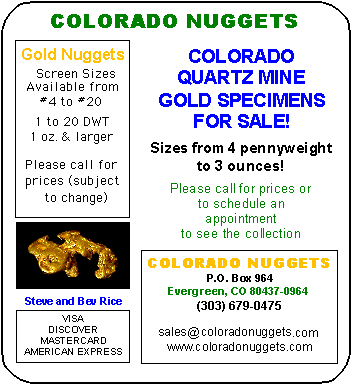

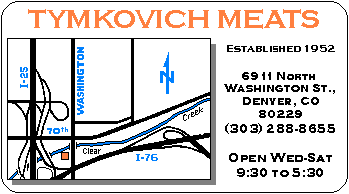
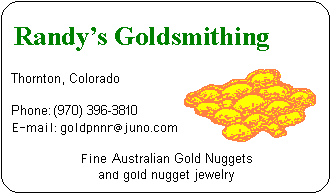

|
is an official publication of the Gold Prospectors of the Rockies, a Denver-based, Colorado nonprofit organization established in 1995 for the enjoyment of gold prospecting and metal detecting. Club meetings are held on the third Wednesday of each month, 7:00 PM, at the Lloyd G. Clements Community Center, 1580 Yarrow Street, Lakewood, Colorado (1 block west of Wadsworth, 1 block north of Colfax). Individual or family membership fees are $30.00 for the first year, $25.00 for each subsequent year. Non-commercial business-card-sized classified text ads for members are free of charge. Commercial display ads must be detecting, prospecting, or treasure related and are available to anyone at a modest charge: 1/8 page (approximately 2"h x 3.5"w business card size) - $6.00 per month. 1/4 page (approximately 4"h x 3.5"w) - $12.00 per month. 1/2 page (approximately 4"h x 7"w or 8.5"h x 3.5"w) - $24.00 per month. Full page (approximately 8.5"h x 7"w) - $48.00 per month. The Gold Nugget is open to and gladly accepts submission of information and articles. All article submissions must be received by the editor no later than the first Wednesday of the month for inclusion in the next month's issue. The GPR must receive any required payments for commercial ads prior to their inclusion. Include publication information on articles clipped from other publications. The Editor reserves the right to edit all submissions. Bulletin editors may print any article from this newsletter with credit given to the newsletter and the author. Contact: The Gold Nugget Editor, The Gold Prospectors of the Rockies, PO Box 621988, Littleton, CO 80162-1988. E-mail: The Gold Nugget Editor. |